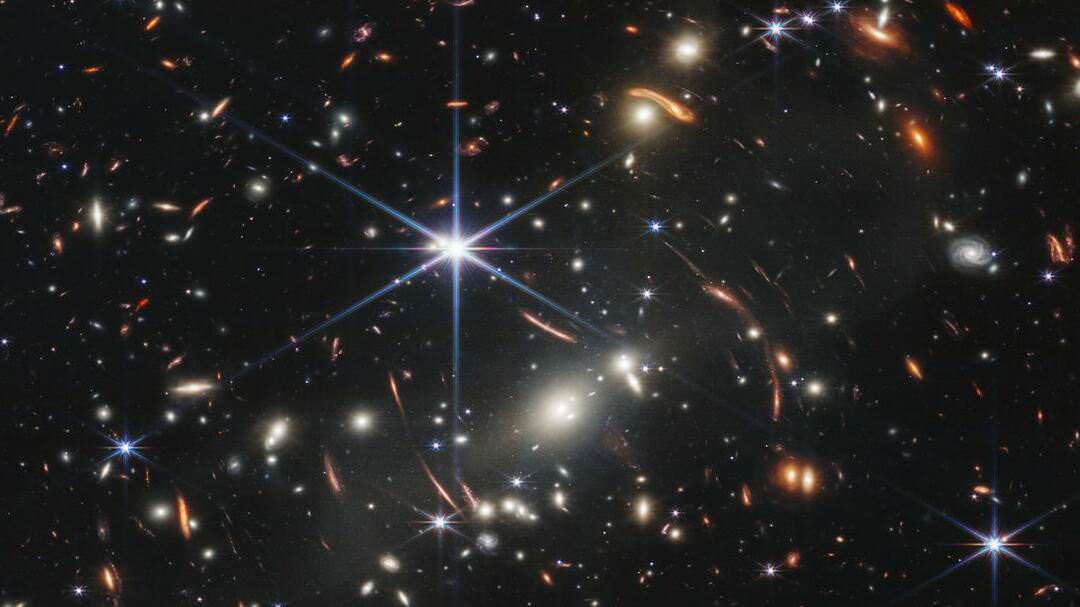
In the previous lesson, we discussed the vast number of galaxies present in the cosmos. However, what exactly is the cosmos? This inquiry has captivated countless generations of individuals. The cosmological theories that have emerged throughout the various stages of human civilization can be regarded as representations of the corresponding era’s understanding of the structure of the universe. In this lesson, we will delve into the evolution of cosmological perspectives regarding the organization of the cosmos. Additionally, we will explore the contemporary theory surrounding the genesis and development of the universe.

Currently, it is not possible to view or share the video lesson with students
In order to access this and other video lessons in the package, you will need to add it to your personal account.
Unlock amazing possibilities


Fundamentals of Modern Cosmology Lesson Outline
The concept of the Universe has been a source of perplexity for numerous generations. Indeed, the cosmological theories that have been formed throughout the course of human civilization can be viewed as the prevailing ideas about the structure of the world during each respective era.
Cosmology is a field of study within astronomy that focuses on investigating the characteristics, organization, and development of the entire Universe. This discipline is rooted in the fields of mathematics, physics, astronomy, and philosophy.
When referring to the Universe, we are referring to the collective assemblage of observable galaxies of various types and their clusters, as well as the intergalactic medium.
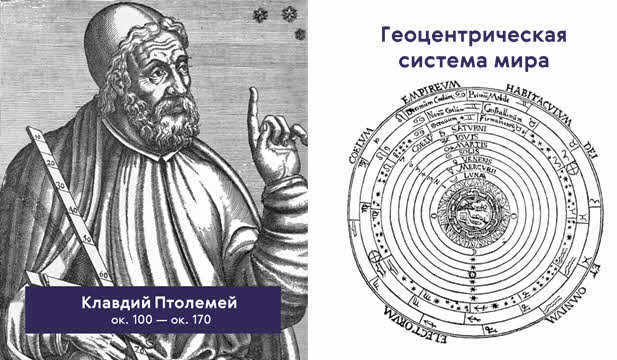
In 1440, Nicholas of Cusa published the groundbreaking treatise “On Scholarly Ignorance” which presented a revolutionary cosmological model of the world. One of the key ideas put forth by Cusa was that the Earth is just one of many planets in the universe. According to his theory, all celestial bodies are inhabited by intelligent beings, and any observer in the universe can consider themselves stationary with equal validity. Cusa also believed that the Universe is infinite in its expanse, although it does have finite dimensions, as infinity is a quality exclusive to God.
Approximately 200 years later, Nicolaus Copernicus introduced a new cosmological model known as the heliocentric system. In this system, Copernicus placed the Sun at the center of the universe, around which all the planets (including Earth) revolve. However, Copernicus still maintained that the universe was confined to a sphere of fixed stars.

Thomas Digges proposed a modification of the Copernican system where the stars are not positioned on the same sphere, but instead exist at varying distances from the Earth, extending to infinity.
Giordano Bruno, an Italian philosopher, took a significant leap from heliocentrism and proposed an infinite universe that is uniformly filled with stars. He was the first to suggest that stars are distant suns and that the laws of physics are consistent throughout boundless and limitless space.
The development of Einstein’s general theory of relativity and elementary particle physics in the early 20th century is closely linked to the emergence of modern cosmology. Interestingly, Einstein himself held the belief that the universe was both homogeneous and isotropic, and most importantly, stationary. Despite the discovery of constant changes in objects within the Universe, Einstein remained convinced that these changes had no impact on the overall appearance of the Universe.
This belief was so ingrained in the mind of the great scientist that he introduced the cosmological constant, also known as the lambda term, into his fundamental GTR equation. This addition was made to ensure that the equation’s solutions would allow for the spatial homogeneity and static nature of the Universe.

In 1922, Alexander Alexandrovich Friedman, a renowned Russian mathematician, put forward a dynamic solution to Einstein’s equation. His examination revealed that there could not be a singular solution under any circumstance. Consequently, it became unfeasible to definitively determine the Universe’s form, the curvature of its radius, and whether it is static or not.
However, Friedman’s calculations resulted in three potential outcomes, which we will attempt to clarify using the well-known principles of Newton’s theory of gravitation. Therefore, let us suppose that the matter in the Universe is uniformly distributed. In this case, a galaxy situated on the surface of a sphere with any given radius will experience an attraction towards its center in accordance with the universal law of gravitation:
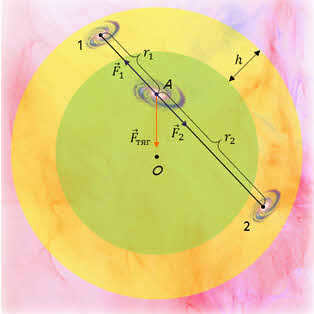
Meanwhile, any other galaxies situated beyond this sphere are unable to alter the strength of this force, as their contributions would be equal in magnitude but opposite in direction. Consequently, the galaxy we are observing is propelled towards the center of the sphere, accelerating under the influence of gravitational forces:

The presence of a negative sign indicates that the acceleration signifies attraction rather than repulsion.
From this equation alone, it is evident that the Universe cannot remain stationary, as gravitational forces are at work within it.
The discovery of Edwin Hubble in 1929, known as Hubble’s law, provided confirmation for the non-stationary model of the Universe, showcasing its expansion.
Following the revelation of Hubble’s law, Einstein admitted that “the inclusion of the cosmological constant was my greatest error.” And for good reason. But we’ll delve into that further on.
The movement of galaxies, which occurs in all directions away from us, does not imply that our Galaxy holds any special position in the Universe. The same pattern of galaxies “scattering” would be observed for any other galaxy as well.
Allow me to illustrate with a straightforward illustration. Imagine we are situated in a particular galaxy, which we will call Galaxy A. From Galaxy A, let’s visualize a direct line extending through space. Along this line, there will be multiple galaxies, each of which is receding from us in accordance with Hubble’s law.
Now, let’s shift our attention from Galaxy A to another galaxy, which we will refer to as Galaxy B. Galaxy B is also moving away from us. Our objective is to determine the velocities of all the galaxies in relation to Galaxy B. To accomplish this task, you and I need to subtract the velocity of Galaxy B from the velocities of the other galaxies.

It is evident that we have obtained an image that is essentially identical to the original one. In other words, the speeds of galaxies remain directly proportional to their distances.
To estimate the approximate time when the observed expansion of the Universe began, we may employ the Hubble constant.
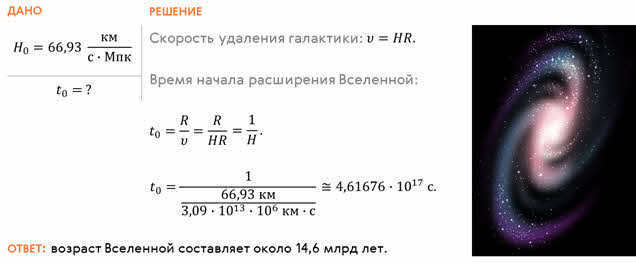
Meanwhile, let’s go back to the research of Friedman and Hubble, who demonstrated that the Universe cannot remain in a stationary state. The fact that galaxies are moving away from each other suggests that they were much closer in the past. Additionally, calculations based on Friedman’s cosmological models indicated that at the point when expansion began, the matter of the Universe must have had an incredibly high density confined within an extremely small volume. However, the question remains: why did the universe start expanding?
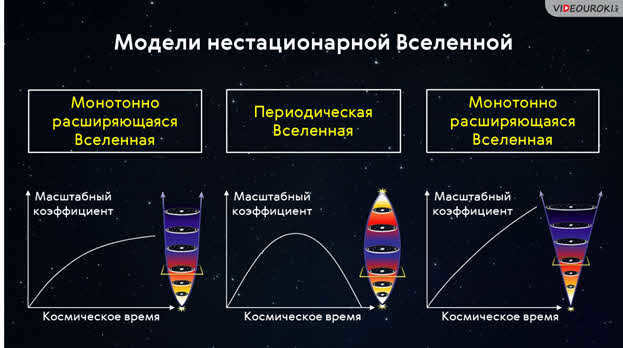
In their individual investigations, Belgian priest Georges Lemaître and Soviet-American physicist Georgy Antonovich Gamow independently put forth a novel concept of a heated Universe in order to address this query. According to this proposition, during the initial phases of expansion, the Universe was distinguished by not only a significant concentration of matter, but also an elevated temperature. This theory was subsequently named the Big Bang.
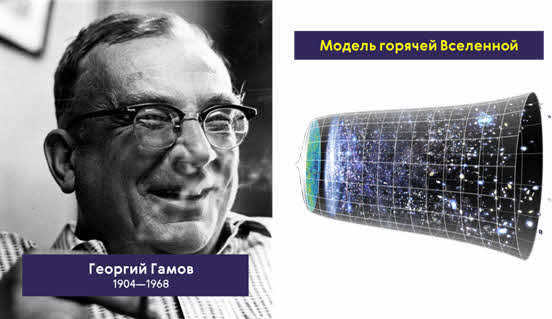
380,000 years after the Big Bang, the temperature dropped to a level where hydrogen atoms could finally exist. Prior to this, the balance between ionization and recombination of protons and electrons was maintained. One million years into the expansion, the era of matter began, leading to the development of the diverse world we know today. This world emerged from a hot plasma of hydrogen and helium, with a few other nuclei mixed in.
In 1964, Anro Penzias and Robert Wilson, radio astronomers from the United States, successfully observed and measured the temperature of the cosmic background radiation. The temperature was determined to be precisely 3 K, marking a significant breakthrough in the field of cosmology. This discovery, comparable to Hubble’s revelation about the overall expansion of the Universe, provided strong evidence in support of Gamow’s theory.
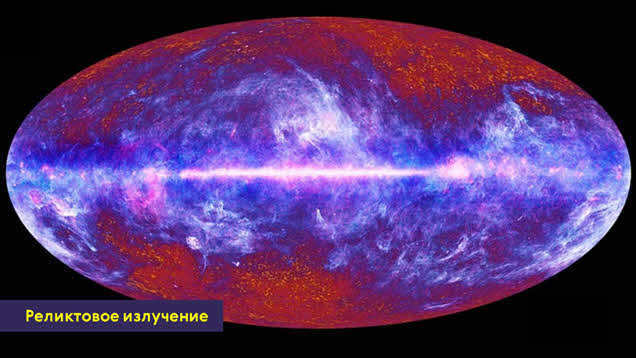
It appeared that was the conclusion. The concept of a hot expanding Universe, which is based on the research of Friedman and Gamow, gained widespread acceptance. However, the Universe mocked humanity’s attempts to understand it and posed a new inquiry: how will its expansion unfold in the times ahead?
In order to address this inquiry, it was imperative to ascertain the correlation between the velocity at which a galaxy is moving away and its distance. On the surface, it may seem like a straightforward task if we employ Hubble’s law. However, it is not as simple as it appears; the actual value of the Hubble parameter must be determined beforehand. To achieve this, it is necessary to measure the redshift values for galaxies, whose distances have already been calculated using alternative methods, such as photometric parallax. Consequently, it is established that the flux of photons emanating from a radiation source and detected by an observer is inversely proportional to the square of the distance to the source:

Therefore, by acquiring knowledge of the radiant energy (also known as luminosity) of a detected entity and assessing the intensity of light, it becomes feasible to determine the distance at which said entity is positioned.

In astronomy, “standard candles” are utilized to fulfill this objective. These are objects whose luminosity is pre-determined. Currently, Type Ia supernovae are considered the most reliable “standard candles” for cosmological observations. This is attributed to the fact that all Type Ia supernovae flares, which are situated at an equal distance, should exhibit nearly identical observed brightness.
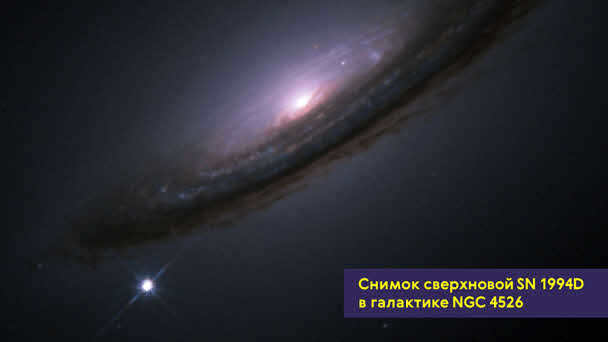
By comparing the observed luminosity of supernovae in various galaxies, we can ascertain the distances to these galaxies.
Therefore, in the late 1990s, it was uncovered that supernovae in distant galaxies, whose distances were determined using Hubble’s law, exhibit a lower luminosity than expected. In other words, the distance to these galaxies calculated using the “standard candle” technique is greater than the distance calculated based on the previously established value of the Hubble parameter. This discovery led to the conclusion that the Universe is not only expanding, but it is expanding at an accelerating rate.
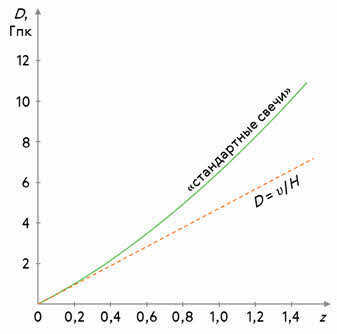
Furthermore, scientists have concluded that the observed acceleration is responsible for the creation of a previously unidentified form of matter that possesses antigravity properties. This has led to the development of a theoretical energy known as dark energy.
The unexpected discovery of antigravity has served to validate Einstein’s foresight, as the formidable and enigmatic lambda term has once again made its way into the equation of general relativity.
Subsequent observational data has demonstrated that dark energy is distributed fairly uniformly throughout the expanse of the universe. Additionally, a study conducted by the “Planck” space observatory in March 2013 revealed that dark energy accounts for 68.3% of the total mass-energy of the observable universe, while dark matter constitutes 26.8%.

Based on these discoveries, a novel cosmological model of our Universe was proposed by scientists, known as the Lambda-Sea model. This new model, referred to as the Lambda-SiDiEm model (ΛCDM), also allowed for the determination of the Universe’s age – 13.75 ± 0.11 billion years.
Therefore, the advancement of modern cosmology has once again demonstrated the boundless capabilities of the human intellect, capable of investigating the most intricate processes that have unfolded in the Universe over billions of years.
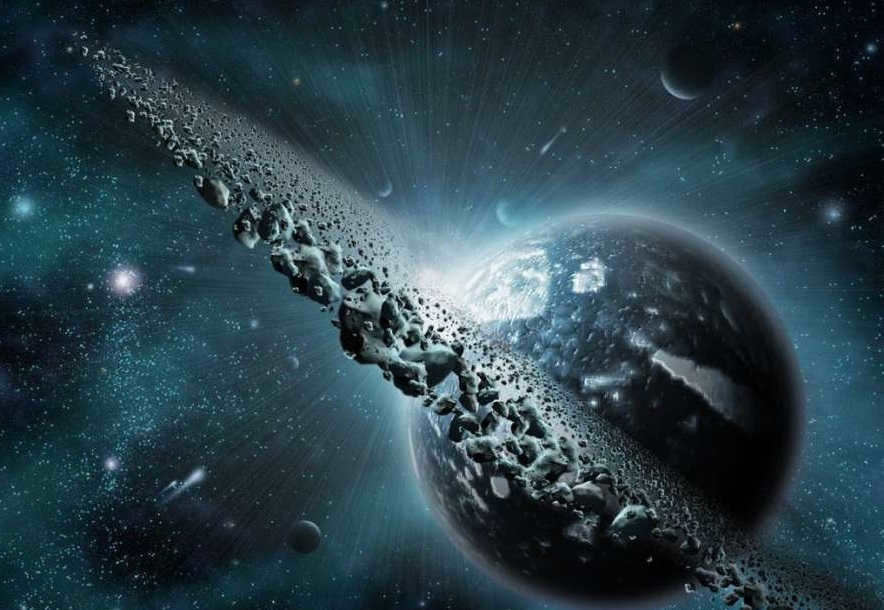
Most people consider the terms “Cosmos” and “Universe” to be interchangeable. However, there is a distinction between the two, and grasping the interpretation of these terms will help clarify the difference.
Distinguishing the Cosmos from the Universe
The concept of the “cosmos” encompasses everything beyond the Earth’s atmosphere. It is an inconceivably vast expanse that includes a multitude of celestial bodies, such as planets, comets, black holes, asteroids, meteorites, and more. Space can be categorized into near space, which has been extensively explored by humans using specialized equipment, and far space, which remains beyond our current reach for exploration.
If we discuss the Universe, it can be understood from various perspectives. From a philosophical standpoint, it encompasses the entirety of existence, and humans are an inseparable component of this vast cosmic entity.
Additionally, there is the notion of the “astronomical universe.” In astronomy, the Universe refers to a segment of the cosmos that can be explored and comprehended through contemporary techniques and tools, ranging from Earth to the reachable interstellar expanse. The true nature of this space, however, remains a mystery, as there is currently no definitive information regarding its infinite characteristics.
If we inquire: which is larger – the cosmos or the Universe, the inquiry will persist without a definitive response, just as the inquiry regarding the disparity between the Universe and the cosmos. There exists a particular viewpoint that the inception of the world is the cosmos (the magnitude of the cosmos is immeasurable), while the observable universe materialized as a consequence of the detonation. There is also an equally reputable viewpoint – the entirety of the universe constitutes a unified entity, and the cosmos merely comprises a fraction of it.
Categories of celestial bodies
The majority of space in the Universe is a vacuum. However, within this vacuum, there are various celestial bodies that differ greatly in size and characteristics.
Let’s explore the primary categories of cosmic bodies.
Star: A luminous gas ball that is tremendously large. Stars are the shimmering objects visible in the night sky. The star closest to Earth (excluding the Sun) is Proxima Centauri, located at a distance of 39,900,000,000,000,000,000,000 kilometers. The Sun, in comparison, is 149.6 million kilometers away. Our Sun accounts for 99.86% of the entire solar system’s mass. It has an age of 4.57 million years, which is half of its lifespan.
Stars can be further classified into various types:
- A red giant is massive in size, gradually expanding and cooling down, and it is characterized by a bright red or orange color.
- When red giants exhaust a significant part of their mass into outer space, they transform into white dwarfs, which are essentially the cores of these giants composed of dense hot matter. In the future, a white dwarf can evolve into a black dwarf.
- In some cases, during the formation of a star, it may not reach the necessary critical mass required to become a fully-fledged luminary. As a result, it becomes an underdeveloped cluster known as a brown dwarf. While a brown dwarf does not emit light or heat, it is too large to be classified as a planet.
- A cepheid is a pulsating star that exhibits varying intensities of brightness due to changes occurring around or within the star itself.
- A supernova is an event that occurs when large stars explode;
- A black hole is a dead star with such a high density that it prevents light from passing through;
- A pulsar, which is also a dead star, has a lower density than a black hole and rotates quickly, emitting gamma rays; it appears to blink. One type of pulsar is a neutron star, which has a higher density. According to the theory proposed by scientist and astronomer Chandrasekar Sabramanian, a neutron star has a core mass that is 1.4 times larger. If it is less, it becomes a white dwarf, and if it is more, it becomes a black hole;
- A double star is a pair of luminaries that are connected by gravity and orbit around a single center.
An exoplanet is a term used to describe a planet that exists outside of our solar system. These planets differ greatly from Earth, with many resembling Saturn or Jupiter. Each exoplanet possesses its own unique characteristics. For instance, the planet TrES-2b reflects an incredibly small amount of light, making it exceptionally dark. Conversely, the planet 55 Cancri is composed of diamonds! On CoRoT-7 b, one side experiences extreme cold, while the other is subjected to intense heat, resulting in a rain of stones. Additionally, HD189733b experiences constant rainfall of glass, while Gliese 436b is made up of luminous ice. There have also been discoveries of planets that exist independently, not belonging to any specific system, making them cosmic orphans.
A nebula is a cloud of gas and dust that serves as a birthing ground for stars. Different types of nebulae include:
- Emission nebulae are known for emitting extraordinary light, often leading to the formation of stars.
- Reflective nebulae are mainly composed of dust and hydrogen, actively reflecting light. They are frequently mixed with emission nebulae.
- Dark nebulae consist of cold gas and dust, and they do not reflect light.
- Planetary nebulae are formed when a star dies.
- Supernova remnants are created when supernovae explode.
Galaxies. There are three types of galaxies:
- Spiral galaxies are characterized by a bulging center and a flat disk with spiral arms. There are normal spiral galaxies, as well as galaxies with a lintel, which have a partition dividing the nucleus into two parts and serving as the base for the arms. The Milky Way Galaxy, where Earth is located, is a spiral galaxy.
- An elliptical galaxy is characterized by the absence of a nucleus and arms, and has an elongated shape. It is the most common type of galaxy and can vary in size from very small to very large.
- An irregular galaxy has no definite shape and is a chaotic cluster of nebulae and stars. It is a rare type of galaxy.
Interesting facts about the universe
Here are a few interesting facts about the universe:
- If the catastrophe theory of the cosmos-universe, in which our Earth exists, is true, then the theory that the age of this formation is 13.7 billion years old can also be believed. The Universe, whose territory constantly changes its boundaries, is supposed to have a diameter of 150 billion light years.
- According to a theory, the Universe was hotter in the past and its temperature is gradually decreasing as it continues to expand. Scientists estimate that at the beginning of its formation, the temperature was over a billion Kelvin (in comparison, today’s temperature is 2725 Kelvin). As space expands, it loses temperature, posing a threat of global cold to the universe.
- Due to the constant motion of galaxies and their inclination to move further apart, there is a possibility that they may eventually separate to such an extent that an explosion occurs, resulting in the destruction of even atoms.
- It is possible that any dwarf neighbor could be engulfed by the Milky Way, while the Milky Way itself could be engulfed by Andromeda.
Astronomers are continuously exploring the universe and its various objects, including comets, asteroids, meteorites, and the solar system. The utilization of advanced technology in research allows for the discovery of even more fascinating facts.
Cosmology is the study of the entire universe and its development.
Cosmogony refers to the study of the origin and evolution of celestial bodies.
Astronomical scales and astronomical units
According to contemporary understanding, the Universe originated approximately 12-15 billion years ago from an infinitesimally small point. Throughout this entire duration, the Universe has been undergoing expansion. Given that nothing in nature can surpass the speed of light, we can conclude that the size of the Universe cannot exceed , where c represents the speed of light, and T denotes the age of the Universe. As a result, we can make an estimate of the upper limit of the Universe’s size to be
This measurement is so immense that it is challenging to comprehend. When it comes to astronomical calculations, meters are not the most suitable unit of measurement for length. In the field of astronomy, it is more convenient to measure distances in light-years. A light-year represents the distance that light can travel in one astronomical year. We can compute this distance in meters as
Because of the Earth’s movement around the Sun, a star that is observed from our planet appears at different angles throughout the year (Figure 1). This change in position is known as parallax and is caused by the motion of the observer. Parallax can be categorized into three types: diurnal parallax, which is due to the Earth’s rotation; annual parallax, which is caused by the Earth’s revolution around the Sun; and secular parallax, which is a result of the Solar System’s motion within the Galaxy.
The annual parallax of a star, denoted as φ, represents the angle by which the direction to the star changes when an imaginary observer moves from the center of the Solar System to the Earth’s orbit (specifically, to the average distance between the Earth and the Sun).
The Earth’s orbit is quite similar to a circle, with an average radius of about 150 billion meters or 150 million kilometers. This distance is commonly referred to as an astronomical unit (AU) and is used as a unit of measurement for distances within our solar system.
Given that one second represents a very small angle, we can estimate the distance of one parsec using the following formula:
Therefore, one parsec is approximately equal to:
The maximum radius of the Universe, measured in parsecs.
Originally, the term “parsec” was abbreviated as ps. However, to avoid confusion with picoseconds in the SI system, it is now abbreviated as pk.
1 pc = 3.26 sv years = 206,265 AU = 3.086 x 10^16 m.
The universe has a finite mass, which is estimated to be equivalent to tons based on the average density of matter.
Hydrogen is the most abundant element in the universe, with a molar density of 2 grams or kilograms. As a result, there are approximately moles of matter, which equates to a vast number of atoms throughout the entire universe. This number is likely the largest we will ever encounter.
The farthest object that has been discovered thus far is a quasar located 8 billion light years away. Given that the radius of the universe is no more than 15 billion light years, there is not much left to observe beyond the boundary itself. While it may currently be impossible, there is a possibility that someday we will be able to witness a wave of light reflected from the boundary.
Astronomical objects
1. Star. Stars contain up to 90% of all matter in the universe.
The nearest star to us, other than the Sun, is Proxima Centauri.
Proxima Centauri is a red dwarf that belongs to the Alpha Centauri star system, making it the closest star to Earth after the Sun. The term “proxima” comes from the Greek word for “nearest.”
Proxima Centauri is located approximately 4.22 light-years away from Earth, which is equivalent to 270,000 times the distance between Earth and the Sun (an astronomical unit). The refined parallax measurement (using the Hubble Space Telescope) is 768.7 ± 0.3 angular milliseconds.
The star’s parallax was first measured in 1917, prior to which α Centauri was considered the closest star to the Sun.
In 2002, scientists used optical interferometry to measure the angular diameter of Proxima Centauri and found it to be 1.02 ± 0.08 angular milliseconds. This means that Proxima Centauri’s actual diameter is approximately seven times smaller than the Sun’s and only 1.5 times larger than Jupiter’s. Additionally, Proxima Centauri’s mass is about seven times less than the Sun’s and 150 times greater than Jupiter’s.
Currently, the highest speed achieved by Earth vehicles is the second space velocity, which is 11 km/sec. If we were to travel to Proxima Centauri, the nearest star, at this speed, it would take us approximately 115,000 years to reach our destination!
A star is a massive celestial object, consisting of gas that is heated to extremely high temperatures and compressed by the force of gravity. This compression leads to a state where hydrogen and helium undergo thermonuclear reactions, which generate energy that is emitted into outer space.
Essentially, a star can be described as a cosmic thermonuclear furnace.
When we talk about the mass of a star, it is commonly measured in relation to the mass of our Sun. Typically, stars can have masses ranging from 0.1 to 50 times that of the Sun.
There are various classifications for stars based on their characteristics.
Normal stars, including our Sun, are the most common type. They have an average matter density of approximately 1.4 g/cm3.
On the other hand, highly heated stars tend to be smaller in size, with an average matter density of about 50 kg/cm3.
The compression of matter in a star is incredibly intense, causing atomic nuclei to be unable to exist. Instead, electrons bond with protons, leaving only neutrons. The immense gravitational compression is balanced out by nuclear forces. In essence, this type of star can be thought of as a colossal nuclear nucleus. As a result, the density of matter within such a star aligns with the density of matter found within an atomic nucleus: 10 11 kg/cm 3 .
When a star loses its outer layer and its hot core becomes visible, it transforms into a white dwarf. This is what happens to our Sun.
If a star’s mass is 1.4 times that of the Sun, it becomes a neutron star. If a star has a mass of 3 to 5 times that of the Sun, it collapses into a black hole.
A black hole is the most remarkable object in the universe, predicted theoretically. It is a star that is so densely packed that the gravitational force on its surface becomes strong enough to prevent the escape of electromagnetic radiation. Outside of a black hole, nothing can get away, not even light. Its presence can only be detected by the absorption of light from surrounding stellar objects.
2. Quasars are distant cosmic objects that emit powerful radio waves.
3. Pulsars are objects that emit electromagnetic radiation in a highly regular pattern. It is believed that pulsars are binary systems consisting of two neutron stars that rotate rapidly.
4. Galaxies are enormous collections of stars, often numbering in the billions (up to 100 billion). When observed from a significant distance, galaxies can appear as single points of light, similar to individual stars.
The Andromeda Nebula, located 2 million light-years away, is the closest galaxy to our own Milky Way.
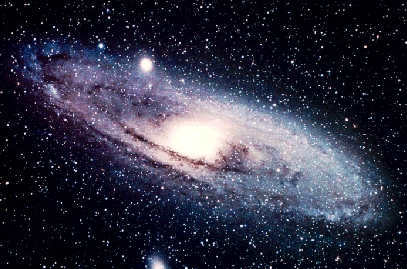
Figure 2: The Andromeda Nebula
Our galaxy is known as the Milky Way.
Modern catalogs contain a multitude of galaxies, with numbers reaching up to 30,000.
Galaxies exhibit various shapes, including spiral, elliptical, and irregular forms.
4. The planets are small celestial bodies, with sizes smaller than 0.002 times that of the Sun. The composition of planets is less dense compared to stars, making thermonuclear reactions impossible. Planets emit light through reflection and are considerably more challenging to observe using telescopes. Therefore, the existence of planets beyond our solar system is purely speculative, although their presence is undeniable.
5. Comets are celestial objects made up of frozen gas and surrounded by a gaseous atmosphere. They orbit the Sun in highly elongated paths and occasionally come close to Earth. During these times, they can be observed using telescopes.
Exploring the origins and evolution of the universe
Human limitations in studying the Universe are greatly hindered by being confined to Earth and the vast time scales involved in universal processes. The primary means of experimentation is through observation. Countless generations of astronomers have dedicated their work to benefit future generations. They meticulously measure and record their findings so that scientists in the distant future can observe the progression of stellar systems. The level of precision required for future theoretical conclusions remains unknown, so astronomers have always strived for utmost accuracy and exactitude in their measurements. The thoroughness of astronomers’ measurements has consistently astounded their contemporaries. Kepler’s discovery of his laws and Newton’s development of the theory of gravitation were made possible by the results of astronomical observations. The most crucial evidence in support of Einstein’s theory of gravity was the highly precise data on the motion of the planet Mercury.
The development of modern cosmology can be attributed to the formulation of Einstein’s theory of relativity and the advent of extragalactic astronomy in 1920.
The Soviet mathematician A.A. Fridman was the first to solve Einstein’s gravitational equations between 1922 and 1924. It was deduced from Fridman’s solution that the universe must be undergoing either contraction or expansion.
In 1929, the astronomer E. Hubble made a groundbreaking discovery known as the red shift. This phenomenon is observed as a shift in the spectral lines of distant stars, indicating that the stars in our Universe are moving away from each other. This suggests that at some point in time, all celestial bodies experienced a significant force, causing them to scatter. If this force was strong enough, the stars would continue moving apart, resulting in the expansion of our visible world. However, if the stars are currently moving away from each other, it implies that they were once in close proximity to each other.
Consequently, there must have been a moment in the distant past when all the matter in the Universe was concentrated in one colossal mass. The gravitational forces within this mass would have been immense, causing it to be compressed into a relatively small size. In order for the present universe to emerge from this concentrated matter, there must have been a powerful explosion. This concept was first proposed by G. Gamow in 1940 and is now known as the Big Bang Theory.
Due to the immense gravitational forces, matter underwent such intense compression that it reached a point-like state. It is impossible for anything to exist in such a state, which is why physicists describe the universe as originating from nothing. Not only atoms, but even elementary particles and photons could not exist in the original matter. However, after approximately 10 to 12 seconds, the temperature dropped to a level where quarks could emerge. Currently, quarks cannot exist freely due to the extremely low temperature. Roughly 10^-3 seconds later, protons, neutrons, and other elementary particles began to form from the quark solution. Within a few seconds, hydrogen and helium started to synthesize. Thus, within a matter of seconds, about 10^50 tons of the universe emerged from nothing.
The concept of the initial phase of rapid expansion in the universe was formulated by Alan Guth (1980). According to this hypothesis, the size of the universe doubled every 10 -34 s. This incredibly rapid expansion was dubbed inflation. Inflation only lasted for a brief period, about 10 -32 s. During this inflationary phase, the universe went from being a billionth the size of a proton to a few centimeters. Just before inflation, there was nothing at all, a state that physicists refer to as the “false” or excited vacuum. There was no matter, no radiation. During inflation, the vacuum expanded and consequently cooled significantly. The universe was empty and cold, much like in the Bible. But where did the immense temperature come from? It turns out that the false vacuum, after expanding and cooling, lost its stability and it was this instability that caused it to explode, generating the vast amount of energy that we observe and rely on today.
Origin of the Universe.
A vacuum in an excited state was compressed into a singularity.
Rapid expansion – inflation.
A cold and empty Universe that was just a few centimeters in size.
An explosion of the excited vacuum led to the birth of energy and a sudden increase in temperature.
The creation of elementary particles.
The Universe was at least 10^14 kilometers in diameter.
The synthesis of hydrogen and helium. The birth of matter as we know it today.
↓ 10 – 15 billion years and here we are in the present.
The visible part of the Universe expands uniformly.
[50, Davis P. Superpower, p. 187 – 204]
How can we forget about the Holy Scriptures?
However, it is important to remember that all these ideas are just hypotheses and are not yet considered legitimate theories.
The origin and development of stars
Stars and star clusters have ages ranging from 10^6 to 10^10 years.
In broad terms, stars undergo the following stages in their development:
1. The formation of a star occurs through the condensation of interstellar dust and hydrogen-rich gas.
2. Hydrogen is converted into helium in the star’s core, which is the longest and most significant stage.
3. As hydrogen is depleted, the core contracts and heats up, causing the envelope to expand significantly. This leads to a drop in surface temperature and the star becoming a red giant.
4. Helium in the core undergoes thermonuclear ignition, sometimes accompanied by the shedding of shells and the formation of a planetary nebula.
5. The remnant star cools down and enters the white dwarf phase.
There are variations depending on the initial mass, as we have already discussed.
Arrangement of the Solar System and traits of the planets
The Solar System comprises of the Sun, the 9 main planets alongside their 34 moons, over 100,000 minor planets (asteroids) positioned between Mars and Jupiter, and an immense number of comets.
Virtually all the mass of the system is concentrated in the Sun, which outweighs all the other planets combined by a factor of 750.
The extent of the solar system spans approximately 80 astronomical units, although a few comets are situated as far as 10^5 astronomical units from the Sun.
The Sun originated from a gas-dust nebula approximately 5 billion years ago. As a result of intense compression, the inner layers of the Sun became sufficiently hot to facilitate the thermonuclear reaction that converts hydrogen into helium. It is believed that temperatures in the central region can reach up to 15 million degrees Celsius. The heat generated from the “burning” of hydrogen is emitted into space and serves as the vital source of sustenance for life on Earth.
The diameter of the Sun is 109 times greater than that of the Earth.
The Sun’s mass is approximately 2-10^30 kilograms.
The outer layer of the Sun, known as the corona, maintains a temperature on the scale of a million degrees.
Terrestrial planets
The group of terrestrial planets consists of Earth, Mercury, Venus, and Mars.
Mercury is the nearest planet to the Sun. It possesses essentially no atmosphere. This is the reason why the surface of Mercury is highly comparable to the Moon’s surface. The side of Mercury facing the Sun experiences temperatures of up to 350 degrees, while during nighttime, temperatures drop to -163 degrees. A single day on Mercury lasts for 176 days on Earth. The outer layers of Mercury are composed of silicates (specifically sandstones), whereas the core is comprised of iron.
Venus. Venus has similar size, density, and mass to Earth. The acceleration of free fall on Venus is 8.6 m/s 2 . Unlike Earth and other planets, Venus rotates in the opposite direction. The rotation speed of Venus is very slow, resulting in a day on Venus lasting 243 Earth days. The atmosphere of Venus is composed of 97% carbon dioxide and only 0.1% oxygen. The surface of Venus is intensely heated, reaching temperatures up to 500°C, due to the greenhouse effect. The presence of a high concentration of clouds made of drops of sulfuric acid solution makes the surface of Venus invisible to observers on Earth.
Earth is located approximately 150 million kilometers away from the Sun. It has a radius of 6378 kilometers and a mass of 6 x 10^24 kg. Earth is estimated to be around 4.5 billion years old.
Mars. Mars is approximately half the size of both Earth and Venus. The atmosphere of Mars is significantly less dense compared to Earth, with a density that is about 100 times lower. In terms of composition, Mars’ atmosphere is similar to Venus’, consisting of 95% carbon dioxide and 0.13% oxygen. The length of a day on Mars is similar to that of Earth. During winter, temperatures on Mars can drop as low as -120ºC, while in summer, they do not exceed 20ºC. The north and south poles of Mars have ice caps made of frozen carbon dioxide. As of now, scientists have not discovered any signs of life on Mars.
Enormous planets
Jupiter, Saturn, Uranus, and Neptune are significantly larger in size compared to the Earth-group planets, despite being composed of lightweight materials. Jupiter and Saturn primarily consist of hydrogen and helium. Uranus and Neptune, on the other hand, are predominantly comprised of icy and rocky substances.
These planets are essentially inhospitable.
Jupiter. With a mass equivalent to 318 times that of the Earth, Jupiter has a diameter of 142,000 kilometers. Unlike Earth, Jupiter lacks a solid surface. Instead, it is covered by a visible layer of clouds. The atmosphere of Jupiter primarily consists of hydrogen and its compounds, including methane and ammonia. The clouds are composed of crystals and droplets of ammonia. The atmosphere gradually compresses, transitioning into a layer of liquid hydrogen that is 24,000 kilometers thick. This is followed by a layer of metallic hydrogen that spans 42,000 kilometers. Within this layer lies a small solid core made of iron and silicates.
Saturn is primarily composed of gas, specifically hydrogen and helium, and lacks a solid surface like what we are accustomed to. It falls under the category of gas planets.
The planet has an equatorial radius of 60300 km and a polar radius of 54000 km, which makes Saturn the most oblate planet in our Solar System. It possesses a mass 95 times that of Earth, yet its average density is only 0.69 g/cm³, making it the least dense planet in our solar system and the sole planet with an average density lower than that of water.
It takes Saturn approximately 10 hours and 39 minutes to complete one rotation on its axis.
Saturn’s iconic rings consist of particles that range in size from tiny microns to several meters, encompassing elements such as ice, rocks, and iron oxide. These rings are separated by gaps, with the largest one being the Cassini division.
Uranus. The composition of Uranus is 83% hydrogen, 15% helium, and 1.99% methane. Additionally, there have been detections of ammonia, ethane, and acetylene in small amounts.
Uranus lacks a distinct core and its matter is distributed relatively evenly. The planet’s blue hue is a result of methane in its atmosphere absorbing red light.
Uranus has a total of 27 known satellites, with the largest ones being Titania, Oberon, Ariel, and Umbriel.
Uranus possesses faint planetary rings that consist of non-luminous particles up to 10 meters in diameter.
Neptune. Neptune, similar to the other gas giants, lacks a solid surface, therefore the size of the planet is measured based on the atmospheric level where the pressure is 1 bar. The equatorial diameter of Neptune is 49528 km, while the polar diameter is 48680 km. Its mass is 1.02×1026 kg, which is 17.14 times greater than Earth’s mass. Consequently, this planet is slightly smaller and denser compared to Uranus. The average density of Neptune is 1.76 g/cm³. The solar energy level near Neptune is significantly low, approximately 8 W/m².
Pluto is the farthest and least explored planet in our solar system. It was first discovered in 1930 by Clyde Tombaugh from the United States. It has a similar composition to the gas giants.
Pluto was officially designated as a planet by the International Astronomical Union in May 1930. At the time, it was believed that its mass was similar to that of Earth, but in reality, Pluto’s mass is nearly 500 times smaller than Earth’s and even less than the Moon’s. The diameter of Pluto is approximately 2274±16 km, which is about two-thirds the size of the Moon.
As a result, there was a debate about whether Pluto should be considered a planet or not. Some suggested classifying objects like Pluto as planetoids or “dwarf planets.” Others argued that the classification of a planet was a “cultural phenomenon” and should not be changed.
Ultimately, on August 24, 2006, during the XXVI General Assembly of the International Astronomical Union, it was decided to officially refer to Pluto as a “dwarf planet” rather than a “planet.”
In Roman mythology, Pluto was known as the god of the underworld, while the Greeks referred to him as Hades (or Hades).
The surface of Pluto appears slightly reddish in images, potentially due to the presence of organic compounds created from nitrogen, methane, and carbon monoxide. Images from the Hubble Telescope reveal the existence of polar caps, which are likely composed of frozen nitrogen. The darker regions on Pluto’s surface are probably covered in methane frost, which has been darkened by solar radiation. Ethane has also been identified on the planet. The alternating light and dark areas may signify the seasonal distribution of frost on Pluto’s surface, although some of it may be influenced by topographic features such as basins and impact craters. It is believed that Pluto’s core is primarily composed of silicates. This composition could account for the planet’s relatively high density of 2.1 g/cm³. The mass of the planet is estimated to be around 1.27×1022 kg, which is equivalent to 0.002 times the mass of Earth. The gravitational acceleration on Pluto is 0.66 m/s² (6.7% of Earth’s), and the escape velocity from the planet’s surface is 1100 m/s.
1) In the early Christian era, the term “world” had multiple meanings. It could refer to a) the inhabited part of the earth or b) the entirety of the earth itself.
2) Additionally, “world” could also denote a region of space that encompassed the entire visible world.
3) Furthermore, “world” could also be used to describe a region of space that encompassed the entire world as a whole.

In the context of Christianity, we can observe the concept that humanity, created by God and seen as the pinnacle of creation, is placed within the meticulously organized environment that was specifically prepared for them.
The term “universe” entered the Russian language as a translation from Church Slavonic, appearing in biblical, sacred, and liturgical texts that describe the earthly surroundings of mankind, the entirety of the cosmos, or its material aspects. This word holds significant theological significance. According to this theological interpretation, humanity is considered to be made in the image of God and serves as the ultimate representation of the universe, embodying the final touch and embellishment bestowed upon the world by God.
The reason for the existence of humanity lies in the beautiful process of becoming divine – in uniting with the non-dual existence of God, in the closest connection with his Creator who is the ultimate source of all possible and impossible perfections. Through this connection, humans are called to transform and elevate the entire world, to spread the grace of life throughout the universe, allowing it to be influenced by the power of grace. In doing so, humans fulfill their universal purpose and destiny. Just as humans themselves become universal in the world, they are also tasked with infusing the world with a special form of divine action, making the presence of the Divine more tangible in the world.
"The salvation of the universe now lies in the hands of man, as man embodies the essence of the cosmos and shares its nature. Within man, the earth finds its own personal and essential significance. Man serves as the universe’s hope for redemption and unity with God." (V.N. Lossky. Dogmatic Theology. Image and Likeness).
In Orthodox theology, the term "universe" encompasses two primary interpretations:
- The realm inhabited by human beings, encompassing the cultural oikoumene, which represents the portion of the universe under mankind’s control.
- The entirety of God’s creation, encompassing the entire universe.
The universe, which serves as the home for human beings on Earth, represents the portion of the world that has been conquered by humanity. It is essentially the cultural realm where humans exist. In the context of Orthodox theology, the concept of the universe is associated with Ecumenical Councils, Ecumenical teachers, and the dissemination of the teachings of the Apostles throughout the cosmos. “An Ecumenical Council is a gathering of pastors and teachers from the Christian Catholic Church, ideally representing the entire universe, with the purpose of establishing true doctrine and promoting order among Christians” (Extended Orthodox Catechism. St. Philaret (Drozdov))
The universe, as the entirety of God’s creation, extends beyond the visible, perceptible world and encompasses the invisible and spiritual realm inhabited by angels.
The concept of “heaven and earth” in the Old Testament reveals the universe as the entirety of creation. It is stated in Genesis 1:1, “In the beginning God created the heavens and the earth,” meaning that God created everything. According to Archbishop Philaret (Gumilevsky), when Scripture refers to God’s creation as heaven and earth, it encompasses all things that exist apart from God. In the New Testament, the universe is referred to as the “cosmos” in Greek (e.g., Jn.17:5 ; Eph.1:24 ; Acts 17:24 ). Archbishop Philaret explains that in the New Testament, the word cosmos does not simply refer to the harmonious order or arrangement of the world, but to the entirety of the world created by God and all its phenomena.
The universe is also known as the entirety of the physical realm. This understanding of the universe is firmly established in modern scientific natural science, particularly within the field of astronomy. Astronomy specifically studies the astronomical universe (metagalaxy) – a segment of the physical realm that can be explored through astronomical methods.
The notion of the universe as the complete physical realm is also embraced by Orthodox theology. This concept acknowledges the fact that humans are integrated into the world of matter and actively participate in all physical processes of the universe through their physical bodies. However, Orthodox theology asserts that the physical world is just one component of the universe created by God. The universe also encompasses the unseen spiritual realm, in which humans engage through their souls.
What does the future hold for the universe according to modern science?
Based on the findings of modern cosmology, the universe is estimated to be 13.7 billion years old. It is currently undergoing rapid expansion, but eventually it will collapse. In about 4 billion years, the Sun will undergo a supernova, resulting in the destruction of the Earth and the entire solar system. Furthermore, in approximately 100 billion years, all matter will decay, leading to a universe that is mostly empty. From a cosmological standpoint, human beings are ultimately doomed. However, Christianity offers the hope of salvation before the final collapse of the universe (A.V. Nesteruk, PhD in Philosophy).
One can consider this as a manifestation of Divine Revelation. God has the ability to effortlessly create both a tiny grain of sand and the vast universe. Perhaps the grandeur and magnificence of the universe exist to help humanity comprehend the immense power of its Creator – God.
According to Sergei Khudiev, there is a scientific hypothesis that suggests the necessity of dimensions for the formation of galaxies, stars, and life in the universe. Despite the initial perception of the universe as vast and empty, it is actually perfectly sized to accommodate life. The precise amount of matter in the universe plays a crucial role in this. If the amount of matter were slightly smaller, the universe would expand too quickly, preventing the formation of galaxies, stars, and planets. On the other hand, if the amount of matter were slightly larger, the universe would stop expanding and eventually collapse under its own gravity. Therefore, upon closer examination, it becomes evident that the universe is exactly the right size to support life.
"In the beginning, God created the heavens and the earth." The heavens and earth mentioned on the first day are not the same as the visible heaven and earth we see. The visible heaven does not appear until the "firmament" on the second day, and the visible earth appears when the dry land is separated on the third day. The "heaven and earth" on the first day refer to the entire universe, both visible and invisible, speculative and material. Heaven encompasses the spiritual worlds that exist beyond our earthly existence, including the countless angelic spheres. The Book of Genesis briefly mentions these spiritual worlds, but primarily focuses on the earth. There are a few references to these spiritual worlds in both the Old and New Testaments, but they are not explored in depth. For example, St. Gregory of Nyssa sees the 99 sheep left on the heights as representing the angelic fullness, while the lost sheep symbolizes our earthly world. In our fallen state, we are unable to determine the place of our universe among the countless other worlds.
This lack of emphasis on the spiritual worlds in Scripture is significant. It highlights the centrality of the earth and establishes a spiritual geocentrism. This geocentrism is not a remnant of primitive cosmology, but rather a symbolic representation. It is not inconsistent with our current understanding of the universe. The earth is spiritually central because it is the physical manifestation of humanity. Man, who is capable of connecting the visible with the invisible, holds a central position in the cosmic structure. Man unites the sensual and the supersensible and therefore participates in the entire framework of "earth" and "heaven" more completely than the angels. The heart of man beats at the center of the universe, and only the saint, whose heart is purified, can fully comprehend whether the "starry spheres" are a reflection of the angelic aeons and thus in need of salvation.
Quotes about the cosmos
"It is crucial for Christians to understand that we are not solitary in the cosmos, that God is not apathetic towards us. It is significant for us to comprehend that in the perspective of God, the Architect of the entire cosmos, we are not abandoned, that we are not some outcasts cowering on the outskirts of the cosmos. The significance of our existence is bestowed by the reality that God did not dispatch us a herald, but came to us Himself. It transpires that in God’s viewpoint we hold importance.
Deacon Andrew

